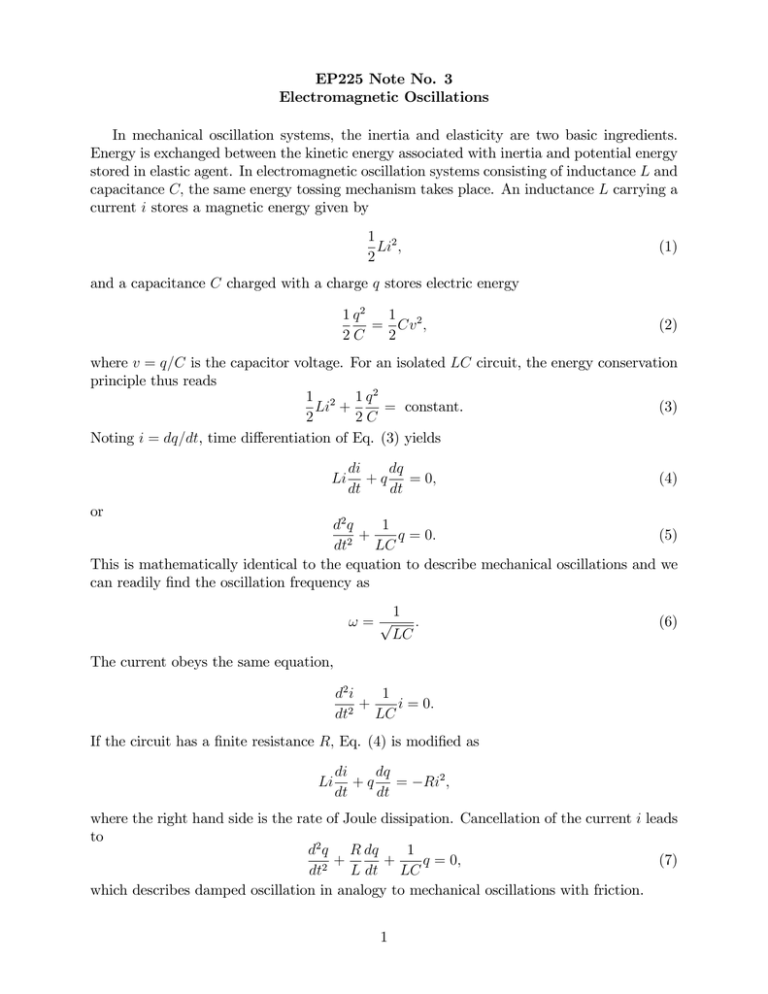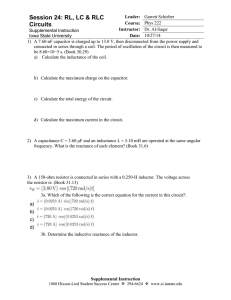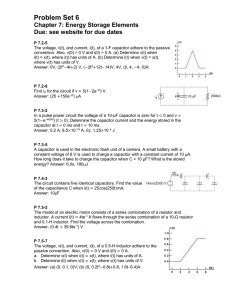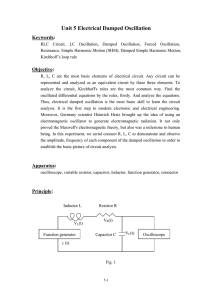EP225 Note No. 3 Electromagnetic Oscillations
advertisement

EP225 Note No. 3 Electromagnetic Oscillations In mechanical oscillation systems, the inertia and elasticity are two basic ingredients. Energy is exchanged between the kinetic energy associated with inertia and potential energy stored in elastic agent. In electromagnetic oscillation systems consisting of inductance L and capacitance C; the same energy tossing mechanism takes place. An inductance L carrying a current i stores a magnetic energy given by 1 2 Li ; 2 (1) and a capacitance C charged with a charge q stores electric energy 1 q2 1 = Cv 2 ; 2C 2 (2) where v = q=C is the capacitor voltage. For an isolated LC circuit, the energy conservation principle thus reads 1 2 1 q2 Li + = constant. (3) 2 2C Noting i = dq=dt, time di¤erentiation of Eq. (3) yields Li dq di + q = 0; dt dt (4) or d2 q 1 + q = 0: (5) 2 dt LC This is mathematically identical to the equation to describe mechanical oscillations and we can readily …nd the oscillation frequency as !=p 1 : LC (6) The current obeys the same equation, 1 d2 i + i = 0: 2 dt LC If the circuit has a …nite resistance R; Eq. (4) is modi…ed as Li di dq +q = dt dt Ri2 ; where the right hand side is the rate of Joule dissipation. Cancellation of the current i leads to d2 q R dq 1 + + q = 0; (7) 2 dt L dt LC which describes damped oscillation in analogy to mechanical oscillations with friction. 1 If a capacitor C charged to a voltage V0 (or charge q0 = CV0 ) is suddenly connected to an inductor L; the capacitor voltage and charge start to oscillate, V (t) = V0 cos !t; q(t) = CV0 cos !t: The current in the circuit ‡owing to the capacitor is i(t) = dq = dt !CV0 sin !t; and the current ‡owing into the inductor is iL (t) = i(t) = !CV0 sin !t: The total energy in the system is 1 2 1 1 1 LiL + CV 2 = L(!CV0 )2 sin2 !t + CV02 cos2 !t 2 2 2 2 1 2 = CV = constant, 2 0 as expected. (Note that ! 2 = 1=LC and sin2 !t + cos2 !t = 1:) The current in the inductor can be rewritten as V0 sin !t: iL (t) = p L=C p The quantity Z = L=C has dimensions of impedance (in Ohms) and is called the characteristic impedance of the LC circuit. Fig. 3.1. LC oscillation system. The concept of impedance will play important roles in propagation of electromagnetic waves in free space. The vacuum permeability is the inductance per unit length, 0 =4 10 7 10 12 H/m and vacuum permittivity "0 = 8:85 F/m is the capacitance per unit length. The quantity r 0 Z0 = = 377 "0 2 is called the characteristic impedance of vacuum. The electric and magnetic …elds of plane electromagnetic waves in vacuum are related through the impedance, E = Z0 H: (Recall that the electric …eld E has dimensions of Volts/m and magnetic …eld H has dimensions of Amperes/m.) Example 1: A capacitor 5 F charged to 1 kV is suddenly connected to an inductor of 2 H. The total resistance of the circuit is R = 5 m : Find (a) an expression for the capacitor voltage as a function of time and (b) the time by which one-half the initial energy has been dissipated. Solution: 1. (a) In the equation for damped oscillation, d2 V R dV 1 + + V = 0; dt2 L dt LC p R=L = 5 m =2 H = 2:5 103 /sec is much smaller than ! = 1= LC = 3:16 105 rad/sec. Therefore, oscillation is weakly damped and the solution for the voltage can be found in analogy to the damped mechanical oscillation in Note 1, V (t) ' V0 e where = R=2L = 1:25 t cos !t; 10 3 = sec : (b) The energy in the capacitor decreases with time according to 1 CV02 e 2 2 t From e 2 t cos2 !t: 1 = ; 2 we …nd 2 t = ln(0:5) = 0:693 0:693 t = = 2:8 10 2 4 sec. Time dependence of the capacitor energy is shown below. 2:5e 2:5 103 t 3 cos2 (3:16 105 t) E 2.5 2.0 1.5 1.0 0.5 0.0 0.0000 0.0001 0.0002 0.0003 0.0004 0.0005 t Example 2: Driven LCR Circuit: If a series LCR circuit is driven by an alternating current generator at a frequency !; Kirchho¤’s voltage theorem reads di q + Ri + = V0 cos !t = V0 Re(ej!t ); dt C where V0 is the generator voltage. (! is the frequency of the generator and has nothing to p do with ! 0 = 1= LC:) Show that the amplitude of the current is given by L i0 = s V0 1 !C !L : 2 + R2 Solution: The impedance of the series LCR circuit is Z = R + j !L 1 !C The current can be found from i = = V V0 ej!t = Z Z V0 ej!t R + j !L 4 1 !C : The magnitude of the current is thus given by i0 = s V0 1 !C !L : 2 + R2 Note that the magnitude of ej!t is unity and that of Z is s 2 1 + R2 : !L jZj = !C The frequency dependence of the current for the case C = 1 mF, L = 1 mH, R = 0:1 is p shown below in log-log scale. The impedance becomes minimum when ! = ! 0 = 1= LC = 103 rad/sec. The current become maximum at that frequency, that is, the circuit resonates with the generator at the resonance frequency. s y 1 :001x 1 :001x 2 + 0:01 9 8 7 6 5 4 3 2 1 0 0 1000 2000 3000 5 4000 5000 x

![Sample_hold[1]](http://s2.studylib.net/store/data/005360237_1-66a09447be9ffd6ace4f3f67c2fef5c7-300x300.png)





